Fishing
Turneffe is the largest coral atoll in the western hemisphere, and provides an incredible variety of saltwater fishing possibilities spread over more than two hundred and fifty square miles of water. From the expansive flat right outside the door of our lodge to the reefs and other flats stretching out for miles in every direction, the 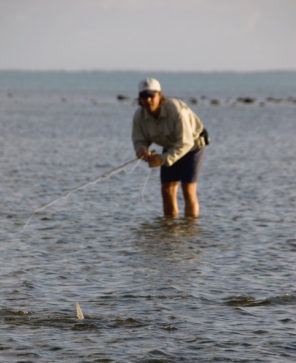 opportunities for wading and poling are both expansive, and diverse. Clients fishing schedules are kept as flexible as possible to account for tides and personal tastes, but generally mean eight or so hours spent on the water each day. Early morning fishing, especially for tarpon, can be quite exceptional, and arrangements can be made with the guides for pre-breakfast fishing if clients so desire.
opportunities for wading and poling are both expansive, and diverse. Clients fishing schedules are kept as flexible as possible to account for tides and personal tastes, but generally mean eight or so hours spent on the water each day. Early morning fishing, especially for tarpon, can be quite exceptional, and arrangements can be made with the guides for pre-breakfast fishing if clients so desire.
Bonefish are the atoll's most commonly sought targets, and are plentifully present in equal numbers all year round. Our ocean-side flats host large schools of fish averaging three to four pounds, with six to eight pound fish being common and double digit fish also making regular appearances in small schools, doubles, and singles. Both wading and poling are approaches that work well for these beaches. The interior of the atoll also sees huge numbers of bones plying the mangrove lined lagoons and soft bottomed flats that we fish from the decks of our custom built flats boats. For most conditions year round 7 or 8 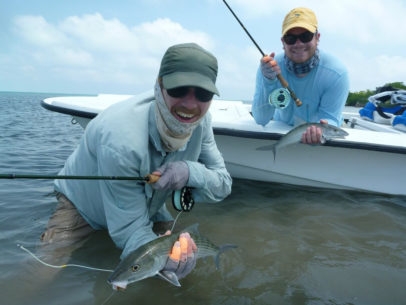 weight rods will deal with any wind encountered while fishing bones at Turneffe, and there is never any need for anything other than a floating line. Flies for these flats tend to be on the small side, usually #6's, but sometimes also #8's or even #10's. A few very well known flies have even been developed here, including the Pops Bonefish Bitters (created by Craig Mathews with the help of our guide Winston "Pops" Cabral) and the ToDyFor which is named after our long time guide, Will Dyer.
weight rods will deal with any wind encountered while fishing bones at Turneffe, and there is never any need for anything other than a floating line. Flies for these flats tend to be on the small side, usually #6's, but sometimes also #8's or even #10's. A few very well known flies have even been developed here, including the Pops Bonefish Bitters (created by Craig Mathews with the help of our guide Winston "Pops" Cabral) and the ToDyFor which is named after our long time guide, Will Dyer.
Tarpon are present year round on the atoll as well, with additional migratory fish augmenting the local population each year. Tarpon numbers begin to increase in April or May and drop off in September or October with peak tarpon months being June, July, and 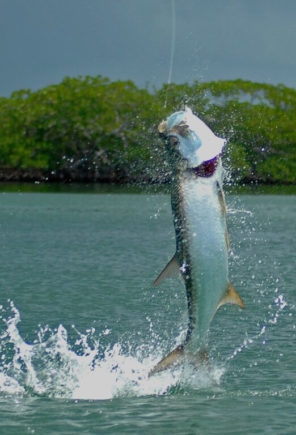 August. Most tarpon jumped are between sixty and ninety pounds, with some fish in the hundred to hundred and fifty pound range, and occasional monsters going a full two hundred pounds. Tarpon are mostly targeted in the interior creeks, channels, and lagoons of the atoll, although they can certainly be encountered in any location at any time. Rods for tarpon should be either 11 or 12 weights. Both floating and sinking lines should be brought in order to pursue tarpon, preferably on two different large arbor disc-drag reels each with at least two hundred yards of thirty pound backing. One of the best sinking lines to use is the clear SA Mastery Series WF-S Line, i.e. their Slime Line. This is a slow-sink line which allows you to fish at various depths and we think it is better and more versatile than a sink tip. Flies should be either 3/0 or 4/0 sizes, and a selection of patterns for our fish would include the Cockroach, Black Death, and Purple Haze in orange/red and white/red, as well as Abel Anchovies and various colors of Deceivers. Dark colors tend to be better in the early morning and brighter colors work best when it’s bright.
August. Most tarpon jumped are between sixty and ninety pounds, with some fish in the hundred to hundred and fifty pound range, and occasional monsters going a full two hundred pounds. Tarpon are mostly targeted in the interior creeks, channels, and lagoons of the atoll, although they can certainly be encountered in any location at any time. Rods for tarpon should be either 11 or 12 weights. Both floating and sinking lines should be brought in order to pursue tarpon, preferably on two different large arbor disc-drag reels each with at least two hundred yards of thirty pound backing. One of the best sinking lines to use is the clear SA Mastery Series WF-S Line, i.e. their Slime Line. This is a slow-sink line which allows you to fish at various depths and we think it is better and more versatile than a sink tip. Flies should be either 3/0 or 4/0 sizes, and a selection of patterns for our fish would include the Cockroach, Black Death, and Purple Haze in orange/red and white/red, as well as Abel Anchovies and various colors of Deceivers. Dark colors tend to be better in the early morning and brighter colors work best when it’s bright.
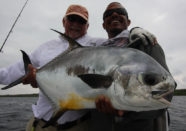
Permit are perhaps the most sought after and challenging sportfish targeted by fly anglers today; and Belize is an excellent place to pursue them. Countless anglers have celebrated the landing of their first permit at Turneffe Flats, and for those willing to make that pursuit a priority, our guides are ready and willing to do everything in their power to make it happen. Permit are found in singles and small groups throughout the Turneffe atoll, but we frequently find even large schools of these elusive fish tailing in shallow water. Most anglers specifically targeting permit will fish throughout the day from poled skiffs, but wading anglers frequently encounter 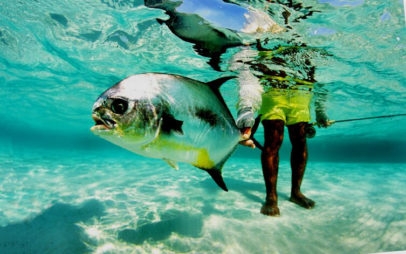 chances too, even while pursuing bonefish. Accuracy of presentation and often also distance can be critical factors in hooking up with these amazing fish. Permit at Turneffe average 15 to 18 pounds but large permit exceeding 40 pounds are regularly seen. Rods in weights 9 or 10 are the norm for permit, coupled with reels that hold at least two hundred and fifty yards of backing. Larger crab patterns are the go-to flies, with Enrico Puglisi's "EP Merkin" in either tan or olive being our number one choice. Other good patterns include the "Bauer Crab" developed by Will Bauer and the "Turneffe Crab" originated by Craig Mathews. Stiffer than normal leaders are generally required to turn over these heavy patterns, and we have our own fluorocarbon tipped leader pattern that can be given to clients in advance of their trip. Otherwise stiff-butted fluoro leaders ending in 15 to 18 pound tippet are advisable.
chances too, even while pursuing bonefish. Accuracy of presentation and often also distance can be critical factors in hooking up with these amazing fish. Permit at Turneffe average 15 to 18 pounds but large permit exceeding 40 pounds are regularly seen. Rods in weights 9 or 10 are the norm for permit, coupled with reels that hold at least two hundred and fifty yards of backing. Larger crab patterns are the go-to flies, with Enrico Puglisi's "EP Merkin" in either tan or olive being our number one choice. Other good patterns include the "Bauer Crab" developed by Will Bauer and the "Turneffe Crab" originated by Craig Mathews. Stiffer than normal leaders are generally required to turn over these heavy patterns, and we have our own fluorocarbon tipped leader pattern that can be given to clients in advance of their trip. Otherwise stiff-butted fluoro leaders ending in 15 to 18 pound tippet are advisable.
Grand Slam Season: June, July and August are our best overall fishing months for the grand slam because there are good numbers of all three species available. Summer temperatures are in the low-to mid-90s and a steady trade wind generally makes the weather very comfortable. Our centrally air-conditioned rooms make for comfortable sleeping throughout the summer.
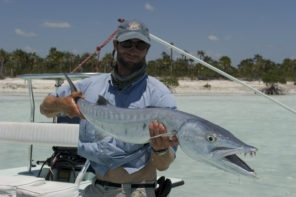
Other species commonly pursued include snook, snappers, jacks, and barracuda, the last of which is perhaps the most under-appreciated gamefish on the flats. Any clients wishing to pursue any of these fish need only ask their guides and will soon find themselves with opportunities to cast at them presented.
Turneffe Flats Guides pole sixteen foot Dolphin Super Skiffs, custom built in the 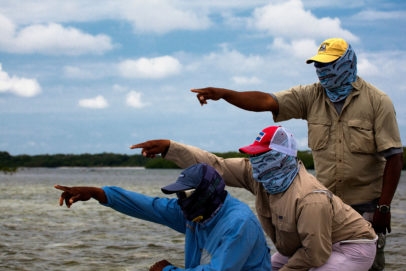 United States just for our location. They cut the chop when making distance and stay afloat in the skinniest of water, with space to store six assembled rods which allows anglers to have a different stick rigged for each species they might encounter. Our guide team is 100% English speaking, and built from a team of the most experienced local fish spotters in the country.
United States just for our location. They cut the chop when making distance and stay afloat in the skinniest of water, with space to store six assembled rods which allows anglers to have a different stick rigged for each species they might encounter. Our guide team is 100% English speaking, and built from a team of the most experienced local fish spotters in the country.